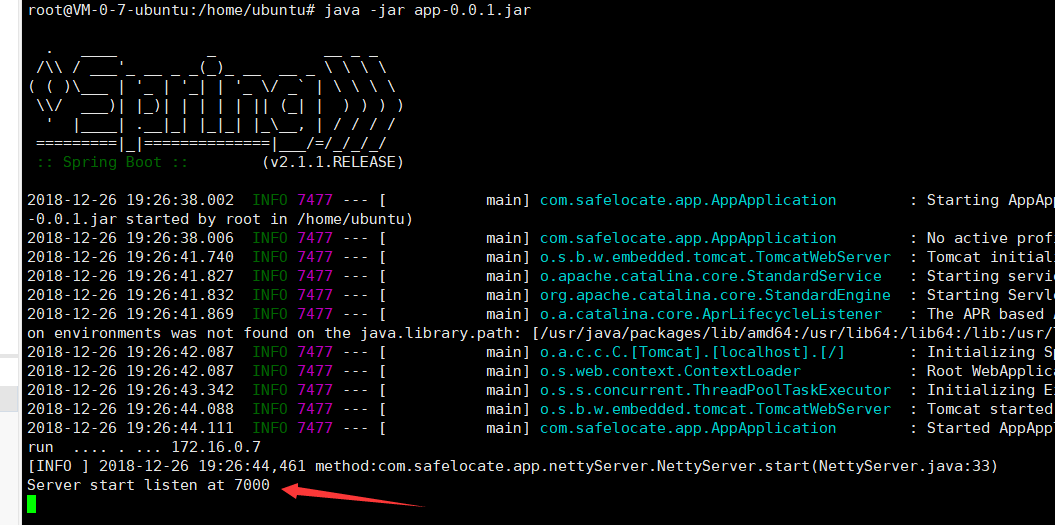您好,登錄后才能下訂單哦!
您好,登錄后才能下訂單哦!
這篇文章給大家介紹怎么在Spring Boot中利用netty實現客戶端服務端交互,內容非常詳細,感興趣的小伙伴們可以參考借鑒,希望對大家能有所幫助。
首先,當然是在SpringBoot項目里添加netty的依賴了,注意不要用netty5的依賴,因為已經廢棄了
<!--netty--> <dependency> <groupId>io.netty</groupId> <artifactId>netty-all</artifactId> <version>4.1.32.Final</version> </dependency>
將端口和IP寫入application.yml文件里,我這里是我云服務器的內網IP,如果是本機測試,用127.0.0.1就ok
netty: port: 7000 url: 172.16.0.7
在這之后,開始寫netty的服務器,這里服務端的邏輯就是將客戶端發來的信息返回回去
因為采用依賴注入的方法實例化netty,所以加上@Component注釋
package com.safelocate.app.nettyServer;
import io.netty.bootstrap.ServerBootstrap;
import io.netty.channel.*;
import io.netty.channel.nio.NioEventLoopGroup;
import io.netty.channel.socket.nio.NioServerSocketChannel;
import org.apache.log4j.Logger;
import org.springframework.stereotype.Component;
import java.net.InetSocketAddress;
@Component
public class NettyServer {
//logger
private static final Logger logger = Logger.getLogger(NettyServer.class);
public void start(InetSocketAddress address){
EventLoopGroup bossGroup = new NioEventLoopGroup(1);
EventLoopGroup workerGroup = new NioEventLoopGroup();
try {
ServerBootstrap bootstrap = new ServerBootstrap()
.group(bossGroup,workerGroup)
.channel(NioServerSocketChannel.class)
.localAddress(address)
.childHandler(new ServerChannelInitializer())
.option(ChannelOption.SO_BACKLOG, 128)
.childOption(ChannelOption.SO_KEEPALIVE, true);
// 綁定端口,開始接收進來的連接
ChannelFuture future = bootstrap.bind(address).sync();
logger.info("Server start listen at " + address.getPort());
future.channel().closeFuture().sync();
} catch (Exception e) {
e.printStackTrace();
bossGroup.shutdownGracefully();
workerGroup.shutdownGracefully();
}
}
}當然,這里的ServerChannelInitializer是我自己定義的類,這個類是繼承ChannelInitializer<SocketChannel>的,里面設置出站和入站的編碼器和解碼器
package com.safelocate.app.nettyServer;
import io.netty.channel.ChannelInitializer;
import io.netty.channel.socket.SocketChannel;
import io.netty.handler.codec.string.StringDecoder;
import io.netty.handler.codec.string.StringEncoder;
import io.netty.util.CharsetUtil;
public class ServerChannelInitializer extends ChannelInitializer<SocketChannel> {
@Override
protected void initChannel(SocketChannel channel) throws Exception {
channel.pipeline().addLast("decoder",new StringDecoder(CharsetUtil.UTF_8));
channel.pipeline().addLast("encoder",new StringEncoder(CharsetUtil.UTF_8));
channel.pipeline().addLast(new ServerHandler());
}
}最好注意被別decoder和encoder寫成了一樣的,不然會出問題(我之前就是不小心都寫成了StringDecoder...)
在這之后就是設置ServerHandler來處理一些簡單的邏輯了
package com.safelocate.app.nettyServer;
import io.netty.channel.ChannelHandlerContext;
import io.netty.channel.ChannelInboundHandlerAdapter;
import io.netty.channel.SimpleChannelInboundHandler;
import java.io.IOException;
import java.io.OutputStream;
import java.io.PrintWriter;
import java.net.InetAddress;
import java.net.Socket;
public class ServerHandler extends ChannelInboundHandlerAdapter {
@Override
public void channelActive(ChannelHandlerContext ctx) {
System.out.println("channelActive----->");
}
@Override
public void channelRead(ChannelHandlerContext ctx, Object msg) throws Exception {
System.out.println("server channelRead......");
System.out.println(ctx.channel().remoteAddress()+"----->Server :"+ msg.toString());
//將客戶端的信息直接返回寫入ctx
ctx.write("server say :"+msg);
//刷新緩存區
ctx.flush();
}
@Override
public void exceptionCaught(ChannelHandlerContext ctx, Throwable cause) throws Exception {
cause.printStackTrace();
ctx.close();
}
}準備工作到這里,現在要做到就是去啟動這個程序
將AppApplication實現CommandLineRunner這個接口,這個接口可以用來再啟動SpringBoot時同時啟動其他功能,比如配置,數據庫連接等等
然后重寫run方法,在run方法里啟動netty服務器,Server類用@AutoWired直接實例化
package com.safelocate.app;
import com.safelocate.app.nettyServer.NettyServer;
import io.netty.channel.ChannelFuture;
import org.springframework.beans.factory.annotation.Autowired;
import org.springframework.beans.factory.annotation.Value;
import org.springframework.boot.CommandLineRunner;
import org.springframework.boot.SpringApplication;
import org.springframework.boot.autoconfigure.SpringBootApplication;
import java.net.InetAddress;
import java.net.InetSocketAddress;
@SpringBootApplication
public class AppApplication implements CommandLineRunner {
@Value("${netty.port}")
private int port;
@Value("${netty.url}")
private String url;
@Autowired
private NettyServer server;
public static void main(String[] args) {
SpringApplication.run(AppApplication.class, args);
}
@Override
public void run(String... args) throws Exception {
InetSocketAddress address = new InetSocketAddress(url,port);
System.out.println("run .... . ... "+url);
server.start(address);
}
}ok,到這里服務端已經寫完,本地我也已經測試完,現在需要打包部署服務器,當然這個程序只為練手...
控制臺輸入mvn clean package -D skipTests 然后將jar包上傳服務器,在這之后,需要在騰訊云/阿里云那邊配置好安全組,將之前yml文件里設定的端口的入站
規則設置好,不然訪問會被拒絕
之后java -jar命令運行,如果需保持后臺一直運行 就用nohup命令,可以看到程序已經跑起來了,等待客戶端連接交互

之后就是寫客戶端了,客戶端其實是依葫蘆畫瓢,跟上面類似
Handler
package client;
import io.netty.channel.ChannelHandlerContext;
import io.netty.channel.ChannelInboundHandlerAdapter;
public class ClientHandler extends ChannelInboundHandlerAdapter {
@Override
public void channelActive(ChannelHandlerContext ctx) {
System.out.println("ClientHandler Active");
}
@Override
public void channelRead(ChannelHandlerContext ctx, Object msg) {
System.out.println("--------");
System.out.println("ClientHandler read Message:"+msg);
}
@Override
public void exceptionCaught(ChannelHandlerContext ctx, Throwable cause) {
cause.printStackTrace();
ctx.close();
}
}ChannelInitializer
package client;
import io.netty.channel.ChannelInitializer;
import io.netty.channel.ChannelPipeline;
import io.netty.channel.socket.SocketChannel;
import io.netty.handler.codec.string.StringDecoder;
import io.netty.handler.codec.string.StringEncoder;
import io.netty.util.CharsetUtil;
public class ClientChannelInitializer extends ChannelInitializer<SocketChannel> {
protected void initChannel(SocketChannel channel) throws Exception {
ChannelPipeline p = channel.pipeline();
p.addLast("decoder", new StringDecoder(CharsetUtil.UTF_8));
p.addLast("encoder", new StringEncoder(CharsetUtil.UTF_8));
p.addLast(new ClientHandler());
}
}主函數所在類,即客戶端
package client;
import io.netty.bootstrap.Bootstrap;
import io.netty.channel.*;
import io.netty.channel.nio.NioEventLoopGroup;
import io.netty.channel.socket.SocketChannel;
import io.netty.channel.socket.nio.NioSocketChannel;
import io.netty.handler.codec.string.StringDecoder;
import io.netty.handler.codec.string.StringEncoder;
public class Client {
static final String HOST = System.getProperty("host", "服務器的IP地址");
static final int PORT = Integer.parseInt(System.getProperty("port", "7000"));
static final int SIZE = Integer.parseInt(System.getProperty("size", "256"));
public static void main(String[] args) throws Exception {
sendMessage("hhhh");
}
public static void sendMessage(String content) throws InterruptedException{
// Configure the client.
EventLoopGroup group = new NioEventLoopGroup();
try {
Bootstrap b = new Bootstrap();
b.group(group)
.channel(NioSocketChannel.class)
.option(ChannelOption.TCP_NODELAY, true)
.handler(new ChannelInitializer<SocketChannel>() {
@Override
public void initChannel(SocketChannel ch) throws Exception {
ChannelPipeline p = ch.pipeline();
p.addLast("decoder", new StringDecoder());
p.addLast("encoder", new StringEncoder());
p.addLast(new ClientHandler());
}
});
ChannelFuture future = b.connect(HOST, PORT).sync();
future.channel().writeAndFlush(content);
future.channel().closeFuture().sync();
} finally {
group.shutdownGracefully();
}
}
}啟動客戶端,這里就是簡單發送一條"hhhh",可以看到客戶端已經收到服務器發來的信息
 |
然后再看服務端,也有相應的信息打印

關于怎么在Spring Boot中利用netty實現客戶端服務端交互就分享到這里了,希望以上內容可以對大家有一定的幫助,可以學到更多知識。如果覺得文章不錯,可以把它分享出去讓更多的人看到。
免責聲明:本站發布的內容(圖片、視頻和文字)以原創、轉載和分享為主,文章觀點不代表本網站立場,如果涉及侵權請聯系站長郵箱:is@yisu.com進行舉報,并提供相關證據,一經查實,將立刻刪除涉嫌侵權內容。